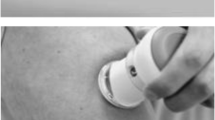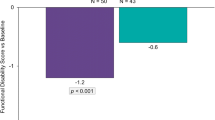Abstract
Purpose
Migraines affect approximately 10% of the adult population worldwide. The purpose of this study was to assess the pharmacokinetic and safety profile of a novel iontophoretic sumatriptan delivery system, NP101, which uses an electrical current to propel sumatriptan across intact skin and into underlying tissue. Four unique prototype iontophoretic sumatriptan patch conditions were compared to a 6 mg subcutaneous injection and an oral 50 mg tablet of sumatriptan succinate.
Materials and Methods
This was a randomized, single-center, single-dose, six-period Phase I study.
Results
Patches were well tolerated with fewer adverse events than the subcutaneous injection. Adverse events that were more prevalent for NP101 than other formulations included localized sensations and reactions at the patch site. A linear relationship was observed between total applied current and sumatriptan delivery. Patches delivering 6 and 12 mA per h yielded favorable sumatriptan systemic profiles, delivering drug at a rate that maintained plasma levels above the target level (≥10 ng/ml) for greater than 7 h.
Conclusions
This study met the initial objective to define the dose–current relationship in humans as well as delimiting specific current and current density targets for a well tolerated patch design that can deliver therapeutic drug levels for longer periods than currently possible.

Similar content being viewed by others
References
L. Morillo. Migraine headache. Am. Fam. Phys. 65:1871–1873 (2002).
L. E. Morillo. Migraine headache. Clin. Evid:1547–1565 (2003).
L. E. Morillo. Migraine headache. Clin. Evid:1696–1719 (2004).
E. Lawrence. Diagnosis and management of migraine headaches. South. Med. J. 97:1069–1077 (2004).
J. Scholpp, R. Shellenberg, B. Moeckesch, and N. Banik. Early treatment of a migraine attack while pain is still mild increases the efficacy of sumatriptan. Cephalagia. 24:925–933 (2004).
S. S. Jhee, T. Shiovitz, A. W. Crawford, and N. R. Cutler. Pharmacokinetics and pharmacodynamics of the triptan antimigraine agents: a comparative review. Clin Pharmacokinet. 40:189–205 (2001).
P. Tfelt-Hansen. Efficacy and adverse events of subcutaneous, oral, and intranasal sumatriptan used for migraine treatment: a systemic review based on number needed to treat. Cephalagia. 18:532–538 (1998).
S. R. Patel, H. Zhong, A. Sharma, and Y. N. Kalia. In vitro and in vivo evaluation of the transdermal iontophoretic delivery of sumatriptan succinate. Eur. J. Pharm. Biopharm. (2006).
Lidocaine transdermal-Vyteris. Drugs R&D. 3:361–362 (2002).
M. Hans, L. Dan, K. Winey, A. Lowman, and S. J. Siegel. Daily to annual biodegradable drug delivery strategies for psychoactive compounds. In S. K. Mallapragada (ed.), Handbook of Biodegradable Polymeric Materials & Applications, American Scientific, Stevenson Ranch, CA, 2004.
S. Siegel. Extended release drug delivery strategies in psychiatry: theory to practice. Psychiatry. 2:22–31 (2005).
G. A. Lattin, R. V. Padmanabhan, and J. B. Phipps. Electronic control of iontophoretic drug delivery. Ann. N.Y. Acad. Sci. 618:450–464 (1991).
C. R. Anderson, R. L. Morris, S. D. Boeh, P. C. Panus, and W. L. Sembrowich. Effects of iontophoresis current magnitude and duration on dexamethasone deposition and localized drug retention. Phys. Ther. 83:161–170 (2003).
C. Anderson, S. Boeh, R. Morris, W. Sembrowich, and P. Panus. Quantification of total dexamethasone phosphate delivery by iontophoresis. Int. J. Pharm. Compd. 7 (2003).
M. D. Ferrari, M. H. James, D. Bates, A. Pilgrim, E. Ashford, B. A. Anderson, and G. Nappi. Oral sumatriptan: effect of a second dose, and incidence and treatment of headache recurrences. Cephalalgia. 14:330–338 (1994).
V. Pfaffenrath, G. Cunin, G. Sjonell, and S. Prendergast. Efficacy and safety of sumatriptan tablets (25 mg, 50 mg, and 100 mg) in the acute treatment of migraine: defining the optimum doses of oral sumatriptan. Headache. 38:184–190 (1998).
R. J. Scott, W. R. Aitchison, P. R. Barker, and G. I. McLaren. Oral sumatriptan in the acute treatment of migraine and migraine recurrence in general practice. QJM 89:613–622 (1996).
A. M. Rapoport, W. H. Visser, N. R. Cutler, C. J. Alderton, L. A. Paulsgrove, R. L. Davis, and M. D. Ferrari. Oral sumatriptan in preventing headache recurrence after treatment of migraine attacks with subcutaneous sumatriptan. Neurology 45:1505–1509 (1995).
A. Chaturvedula, D. P. Joshi, C. Anderson, R. Morris, W. L. Sembrowich, and A. K. Banga. Dermal, subdermal, and systemic concentrations of granisetron by iontophoretic delivery. Pharm. Res. 22:1313–1319 (2005).
A. Chaturvedula, D. P. Joshi, C. Anderson, R. L. Morris, W. L. Sembrowich, and A. K. Banga. In vivo iontophoretic delivery and pharmacokinetics of salmon calcitonin. Int. J. Pharm. 297:190–196 (2005).
C. Duquesnoy, J. Mamet, D. Sumner, and E. Fuseau. Comparative clinical pharmacokinetics of single doses of sumatriptan following subcutaneous, oral, rectal and intranasal administration. Eur. J. Pharm. Sci. 6:99–104 (1998).
Acknowledgments
This work is sponsored by NuPathe Inc. Carol O’Neill and Terri Sebree are employees of NuPathe. Steven Siegel has received grant support and consulted to NuPathe Inc. Russell Morris is an employee of Travanti Pharma, makers of the WEDD technology used in the sumatriptan delivery system described in this manuscript. David Jackson and Louise Dubé are consultants to NuPathe. Peter Kaldeway, the principal investigator and study physician, is an employee of the Kendle International Clinical Pharmacology Unit and has no financial relationship with NuPathe or its subsidiaries.
Author information
Authors and Affiliations
Corresponding author
Rights and permissions
About this article
Cite this article
Siegel, S.J., O’Neill, C., Dubé, L.M. et al. A Unique Iontophoretic Patch for Optimal Transdermal Delivery of Sumatriptan. Pharm Res 24, 1919–1926 (2007). https://doi.org/10.1007/s11095-007-9317-1
Received:
Accepted:
Published:
Issue Date:
DOI: https://doi.org/10.1007/s11095-007-9317-1




